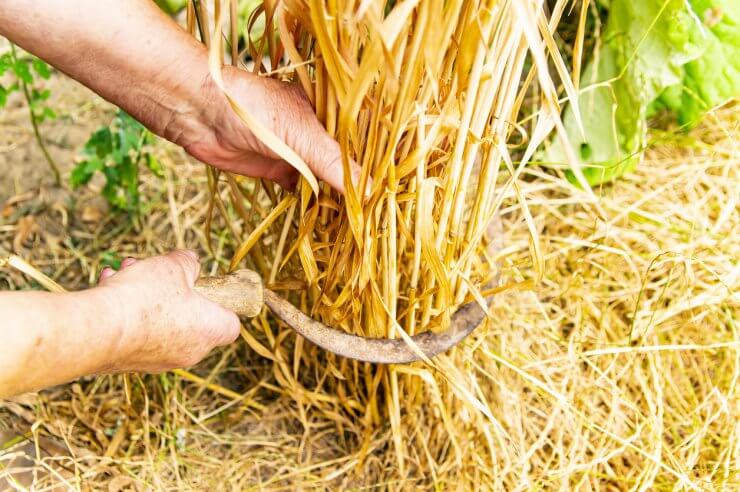
Hand harvesting wheat with a sickle
Wheat matures in 150 to 170 days. While it is growing, you have plenty of time to focus on the rest of your garden. But when harvesting time nears, wheat will need your full attention.
After a couple of months, the wheat will grow, tiller, and produce wheat heads. Once this happens the plants will slowly start to dry out, turning from green to golden brown, brown, or amber, and the heads will start to droop. You must keep a sharp eye on your wheat at this point because you want to harvest it just before it is fully ripe. Once ripe, the seeds begin to fall out and you will lose a lot of usable crop. You can check to see if the kernels are ready by applying your thumbnail—the kernels should dent only slightly. You can also pop one in your mouth and chew it—they should be more hard than chewy.
When the wheat is ready to harvest use a sickle, a scythe, or even a hedge trimmer to cut the stalks close to the ground, leaving stubble. Bunch the cut stalks into sheaves—or bundles—and tie them with twine. Set the wheat in a dry, well-ventilated place to fully dry out. You’ll know when the heads no longer have traces of green.
When the wheat has fully dried, it’s time to thresh it or loosen the grain from the heads. This can be done in a few ways, but essentially you beat the wheat, so it releases the grain. You can beat the heads against the inside of a large barrel; put the wheat inside a pillowcase and slam it against a wall, large rock, or the ground; or lay it on a tarp and beat it with a thresher—a big stick that sometimes has a strip of leather on the end.
Next you need to separate the wheat from the chaff—the light, papery material around the grain. This is called winnowing. Traditionally, farmers tossed handfuls of wheat in the air and the chaff would blow away in the wind. It’s more efficient to spread the grain over a tarp or large sieve and let an electric fan blow the chaff away.
Do you know exactly when to harvest your wheat? Please tell us what you look for when getting ready to harvest.


 Previous
Previous

